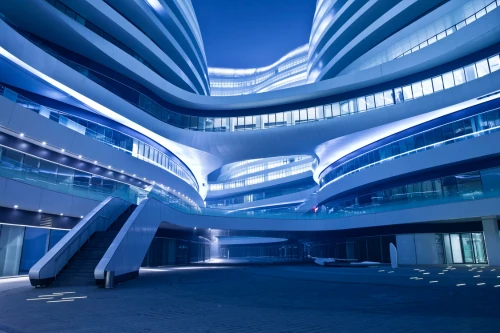
What Buildings Will Look Like in 2035: Data, Design, and Humanity Combined
Picture yourself stepping into a building twelve years from now. There’s no sudden flash of technology, no robotic voice greeting you — just a quiet awareness that the place knows you’re there. The lights soften. The air feels right. The environment responds almost instinctively, as if the building itself understands what comfort means to you.
By 2035, architecture and intelligence will no longer be separate things. The data flowing through walls, floors, and systems will merge seamlessly with design — not to impress, but to make life smoother, fairer, and more human.
Technology with a Human Pulse
The first smart buildings were all about automation, like turning off lights when no one was home or changing the thermostat to save energy. It worked, but it was mechanical. The next generation will go beyond only being able to control things to being conscious of their emotions and combining reasoning with empathy.
Through networks of sensors and connected systems, future structures will learn how people behave, move, and feel. The goal won’t be to overwhelm users with screens or apps, but to make technology invisible — like a nervous system quietly doing its job in the background.
Platforms such as their smart building software are already laying the groundwork for that shift, connecting fragmented systems and translating data into decisions. But in 2035, buildings will go one step further: they’ll not only respond — they’ll interpret.
A Space That Reads the Room
Imagine arriving at work during a storm. As the doors slide open, the temperature rises a touch, and the lighting warms to offset the gray outside. The floor sensors pick up wet footprints and redirect cleaning drones before anyone slips. You don’t notice it happening, but you feel the difference.
That’s how contextual design will work. Instead of static controls, environments will sense what’s needed and act on subtle cues — weather, sound, even emotion. A meeting room might shift tone when conversation gets heated, softening its lights or improving air circulation to help people refocus. The idea isn’t to replace human intention, but to support it.
When the Digital and Physical Merge
Architecture will be a conversation between the real and the digital. Before building ever starts, designers will utilize mixed-reality technologies to examine how light, noise, and air move. Digital twins are living replicas of real environments that will keep learning after a building opens. They will be able to guess how people would use hallways, entrances, and shared spaces.
These invisible counterparts will constantly simulate scenarios — adjusting how a building breathes or reacts to daily routines. The digital layer will act less like an interface and more like intuition, allowing real structures to evolve naturally, almost like organisms.
Design That Responds to Emotion
Space affects mood more than most people realize. Harsh light raises stress levels; stale air dulls concentration. By 2035, emotional architecture will treat these factors not as side effects but as vital design tools.
Hospitals might tune lighting color to calm patients’ heart rates. Schools could adjust acoustics when noise grows overwhelming. Offices may use scent and temperature to reduce fatigue near the end of the day. None of this will feel like technology — it’ll feel like care.
Buildings won’t be talking to us; they’ll be listening.
Sustainability as an Instinct
Environmental awareness will no longer sit on checklists or certificates — it will be part of the building’s DNA. Structures will operate like small ecosystems, recovering heat, recycling water, and producing energy through every surface.
Roofs will filter rain into cooling reservoirs. Windows will generate power while still letting in natural light. AI-driven systems will distribute resources across zones based on need, not schedule. Waste won’t just be reduced — it will be repurposed instantly, almost automatically.
Maintenance, too, will change. Instead of reacting to a fault, systems will sense stress or vibration early and adjust before anything breaks. A building that heals itself may sound poetic, but it’s the direction things are already heading.
The Human Lens
No matter how much data runs beneath the surface, the success of future design will come down to empathy. Architects will think in feelings — how light lands on a table, how footsteps sound in an open hall, how someone with a cane moves through the space.
Accessibility will become seamless, not signposted. Floors will guide through texture, lighting will hint at direction, doors will open with a nod or a glance. Workspaces will adapt to the person sitting there — quieter for some, brighter for others. Comfort will be personal again, just delivered through new tools.
The Role of Artificial Intelligence
Artificial intelligence will act more like a translator than a controller. It will read signals from thousands of sensors — air, motion, temperature, sound — and turn them into everyday comfort.
You’ll be able to ask questions directly: Why does the room feel cooler today? or How much energy did we save this week? The building will answer in plain language, not code. Transparency will replace mystery.
Over time, AI will learn people’s patterns — how long they linger, when they lose focus, when they relax — and shape the environment accordingly. Subtle, not invasive. Helpful, not commanding.
Buildings as Communities, Not Containers
Tomorrow’s buildings will have social memory. They’ll notice patterns that bring people together — spontaneous chats, shared meals, creative bursts — and design for more of them.
Public spaces will double as data hubs, showing local energy output or neighborhood air quality. Conference rooms will morph into quiet zones or collaborative studios depending on the group that enters. Smart kitchens might reduce waste by tracking what’s left behind and suggesting community meals.
The purpose of all this won’t be automation for its own sake — it’ll be connection. Buildings will exist less as boundaries and more as bridges.
Ethics and Trust in Intelligent Spaces
Of course, with intelligence comes responsibility. When a structure learns about the people inside, questions of privacy and ownership naturally follow. Who controls that information? How much should a building know about its occupants?
The answers will shape design laws as much as materials or form do today. Transparency will become a moral standard. Every system will need to explain itself — why it acted, what data it used, and how that data is stored. Trust will become part of the architecture, built as carefully as the walls.
The Companion Building
The buildings of 2035 won’t seem that different from the ones we see now. The way they make you feel will alter; they’ll be peaceful, responsive, and softly alive. The smartest buildings won’t brag about how smart they are; they’ll just make life easier without drawing attention to themselves.
They’ll notice what you need before you ask. They’ll reduce waste without anyone bragging about it. They’ll help people focus, rest, and belong.
Architecture will finally find its balance between code and compassion. Data will no longer compete with design — it will complete it. And humanity will remain at the heart of it all.
If you’re curious where this evolution begins, explore how intelligence can become your optimisation driver.













 Accessibility
Accessibility